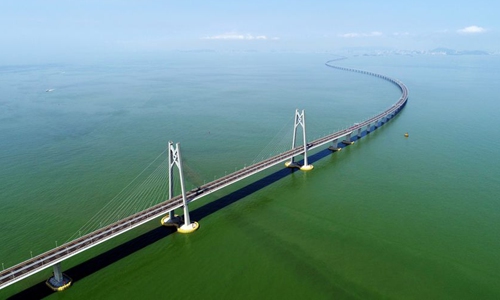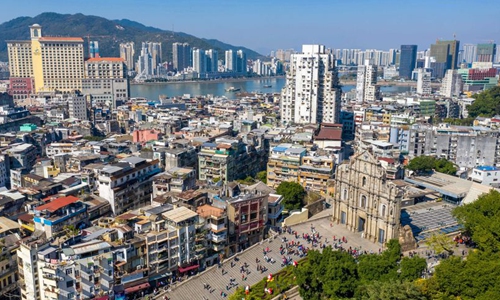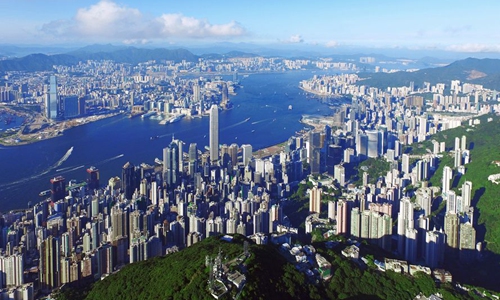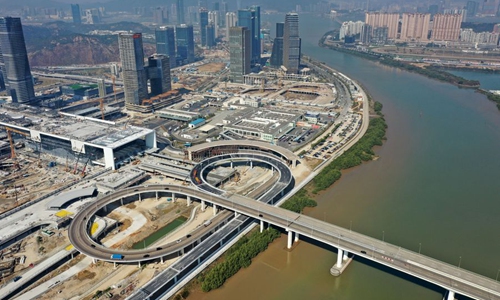HOME >> SOURCE
One year on, China's Greater Bay Area sees steady development
Source:Xinhua Published: 2020/2/19 13:45:59

Aerial photo taken on July 11, 2018 shows the Hong Kong-Zhuhai-Macao Bridge in south China. (Xinhua/Liang Xu)
One year ago, China unveiled a master plan to develop its southern bay area into a world-class city cluster, a global technology and innovation center, and a livable and business-friendly area.
With a string of follow-up measures put in place since then, the bay area, officially known as the Guangdong-Hong Kong-Macao Greater Bay Area, witnessed steady development. Cities in the bay area have built increasingly closer ties with each other and achieved much easier flows of talent, goods and capital.
New vitality has been injected into the bay area with a total area of 56,000 square km, a population of about 70 million, and an economy of 10 trillion Chinese yuan (1.43 trillion US dollars).
With more emerging growth opportunities, the Greater Bay Area is looking forward to an even brighter future, observers said.

Aerial photo taken on Dec. 12, 2019 shows a general view of the Ruins of St. Paul's in Macao, south China. (Xinhua/Cheong Kam Ka)
IMPROVING INTEGRATION
Shortly after the unveiling of the plan, the Chinese government rolled out specific measures in the coming month in an effort to turn the blueprint into reality.
Tax concessions for Hong Kong and Macao people working in mainland cities of the Greater Bay Area were announced in March, among others. Eight months later, more favorable policies were hammered out, such as encouraging those people to purchase properties in nine mainland cities and granting their children equal education there.
Such measures designed to make it easier for people to work across the Greater Bay Area are key to talent mobility, KPMG China's Hong Kong partner Maggie Lee said. "The policies have created tangible benefits for Hong Kong businesses and residents."
Major infrastructure projects including the Hong Kong-Zhuhai-Macao Bridge and the Guangzhou-Shenzhen-Hong Kong Express Rail Link also started operation, which allowed dwellers of the Greater Bay Area to easily travel from one city to another. The transport network has become so convenient that it is even possible to take morning tea in Guangzhou, do business in Hong Kong in the afternoon, and enjoy night view in Macao.
Experts said the improvement in connectivity is still significant to further unlocking the economic potential of the Greater Bay Area, pushing forward integrated development, and bolstering the confidence of businesses in the future of the Greater Bay Area.

Aerial photo taken on June 27, 2017 shows the scenery on the both sides of the Victoria Harbour in Hong Kong SAR, south China. (Xinhua/Lui Siu Wai)
BUSINESSES SPEED UP EXPANSION
A survey jointly conducted by KPMG China, HSBC and the Hong Kong General Chamber of Commerce (HKGCC) showed in January that 747 executives of businesses in the Greater Bay Area are bullish about both their own and the region's prospects, and most of them are planning to expand to other cities in the area.
Union Medical Healthcare (UMH), a non-hospital medical services provider, has given a priority to the Greater Bay Area in its development strategy.
"We are focusing on areas within one-hour travel distance of Hong Kong, where we can tap into potential markets efficiently," said UMH CEO Eddy Tang. "With rapidly-growing GDP of the Greater Bay Area, the health care market there boasts the enormous potential to see booming growth in the future."
The company, currently owning 10 outlets in Guangzhou and Shenzhen, plans to open 30 to 50 more clinics in the mainland in three to five years, mainly in the Greater Bay Area outside Hong Kong.
KPMG China's Lee said firms have become increasingly interested and involved in the Greater Bay Area.
In Hong Kong alone, 96 percent of respondent businesses express confidence in the Greater Bay Area and expect their business revenue will grow, a survey showed. To capitalize on the opportunities, more than half of the businesses either have made a strategic plan or are in the process of formulating one.

Aerial photo taken on Dec. 11, 2019 shows a view of the new Hengqin Port and the Lotus Bridge in Zhuhai, south China's Guangdong Province. (Xinhua/Jin Liangkuai)
OPPORTUNITIES TO SEIZE
Terence Chiu, HSBC's Hong Kong head of commercial banking, expressed strong optimism about the plan on the Greater Bay Area as enormous opportunities will be generated for businesses from the coordinated development of Hong Kong, Macao and nine cities in Guangdong Province.
During the past year, the HKGCC has organized a series of seminars and business tours to discuss and explore the opportunities of the Greater Bay Area, which were in particular welcomed by small and medium-sized enterprises.
"The bay area is one of the few places where businesses can expand their presence and seek higher returns over the next few years," Yu Pang-chun with the HKGCC said, stressing that it has the potential to become the most important opportunity for businesses and reshape Hong Kong's business environment for decades to come.
Yu said companies should not hesitate to enter the Greater Bay Area market. "They should act now in case of missing the chance even if they may not be 100 percent sure that they can seize it."
Posted in: ECONOMY